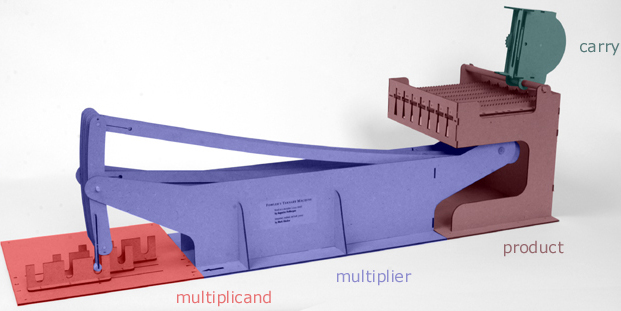Fowler's binary and ternary tables
About
the machine
Overview
Multiplicand
Multiplier
Product
Carry mechanism
Instructions for use
Video demonstration
Fowler's ternary calculating machine - an overview
Thomas Fowler, fearful that his ideas would be stolen by others, designed and built his wooden calculating machine entirely on his own in the workshop behind his printing business. To compensate for the limited precision that he could achieve in wood, the machine was very large: six feet wide by three feet deep and one foot high (180 x 90 x 30 cm.). The model Fowler built has not survived, and almost all other evidence of the machine has disappeared. The descriptions of the machine that follow are based on our interpretation of how Fowler’s machine might have worked, based on the limited information available.
Fowler
had developed a technique that used balanced ternary to simplify complex
monetary calculations for the Poor Law Union, publishing his methods
in his book, Tables for Facilitating Arithmetical
Calculations.
His calculating machine was built several years later, giving mechanical
form to the techniques outlined in the book. The choice of balanced
ternary allowed
the mechanisms
to be very simple. Of course,
it also
required
all the
numerical values to be converted to balanced ternary, and then converted
back to decimal at the end of the calculation. Clearly, this machine
was not practical for simple addition or subtraction problems. Where
the machine became really useful was for complex problems that required
a great number of intermediate calculations in between the conversions
to and
from ternary. The calculations that Fowler faced at the
Poor Law Union were exactly that sort of problem (see An
Example of Calculating With Fowler’s Ternary Tables).

In the
context of a multiplication problem, Fowler’s machine consists
of four distinct sections:
- the multiplicand
- the multiplier
- the product
- the carry mechanism
The machine can also be used for division, but in reverse – the product
becomes the dividend, the multiplier becomes the divisor, and the multiplicand
becomes the quotient. For the purposes of the descriptions that follow, it
is easiest to limit the discussion to problems of multiplication.
